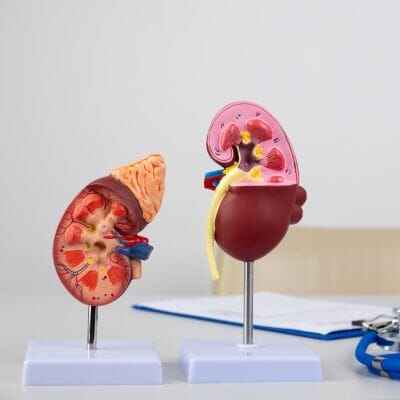What is Polycystic Kidney Disease
Polycystic Kidney Disease (PKD) is a genetic disorder characterized by the development of fluid-filled sacs (cysts) in the kidneys. These cysts can gradually replace normal kidney tissue, leading to a decline in kidney function over time. PKD is a hereditary condition, meaning it is passed down from parents to their children through genetic mutations.
There are two main types of PKD:
- Autosomal Dominant Polycystic Kidney Disease (ADPKD): This is the most common form of PKD and is typically diagnosed in adulthood. In ADPKD, one parent with a mutated gene can pass the disorder to their child. The cysts can grow and enlarge the kidneys, affecting their structure and function.
- Autosomal Recessive Polycystic Kidney Disease (ARPKD): This form is less common and is usually diagnosed in infancy or childhood. Both parents must carry a copy of the mutated gene for a child to inherit ARPKD. Unlike ADPKD, ARPKD often leads to kidney problems early in life.

Causes Of Polycystic Kidney Disease
- Genetic mutations: PKD is primarily caused by mutations in specific genes, most commonly PKD1 or PKD2. These mutations disrupt normal kidney development and function.
- Inheritance patterns: PKD can be inherited in two main ways:
- Autosomal dominant: This is the most common type, where inheriting one copy of the mutated gene from a parent is enough to cause the disease.
- Autosomal recessive: This is a rarer form, requiring two copies of the mutated gene (one from each parent) for the disease to develop.
- Spontaneous mutations: In some cases, PKD can occur due to a new gene mutation in the child, even if neither parent has the disease.
- Other potential factors: While not fully understood, other factors like environmental triggers or interactions between genes might play a role in PKD development and severity.
Symptoms Of Polycystic Kidney Disease
- High blood pressure: This is the most common symptom and can occur even in the early stages of PKD.
- Back or side pain: This can be caused by enlarged kidneys or cysts pressing on surrounding structures.
- Blood in the urine (hematuria): This can be a sign of bleeding within the cysts or due to complications like infections.
- A feeling of fullness in the abdomen: This may be due to the presence of enlarged kidneys.
- Increased size of the abdomen: This can be a visible sign of enlarged kidneys, especially in advanced cases.
- Headaches: These may be related to high blood pressure or the presence of cysts. Urinary tract infections (UTIs): These are more common in people with PKD due to the increased risk of cysts becoming infected.
- Kidney stones: These are also more common in people with PKD due to the abnormal structure of the kidneys.
- Liver cysts: These can occur alongside kidney cysts in people with PKD.
- Heart problems: These can include heart valve abnormalities, arrhythmias, and high blood pressure in the lungs.
- Brain aneurysms: These are rare but can occur in people with PKD.
- Fatigue and anemia: These can be caused by kidney dysfunction and decreased red blood cell production.
Who is at a Higher Risk?
Genetic Factors:
- Family history: Having a parent or sibling with PKD significantly increases your risk.
- Autosomal dominant PKD (ADPKD): Inheritance of one mutated PKD1 or PKD2 gene from a parent puts you at a 50% risk.
- Autosomal recessive PKD (ARPKD): Both parents must carry the mutated PKHD1 gene for each child to have a 25% risk.
Other Factors:
- Age: Onset and severity often increase with age, typically appearing in adulthood.
- Sex: Women with ADPKD may have a slightly faster disease progression than men.
- High blood pressure: Uncontrolled hypertension can accelerate PKD progression.
- Smoking: Smoking is associated with faster cyst growth and earlier kidney failure in PKD patients.
- Congenital malformations: Some individuals with PKD have other birth defects, like heart valve problems or liver cysts.
How To Diagnose Polycystic Kidney Disease
Imaging Tests:
- Ultrasound:
- First-line test for PKD due to its ease, affordability, and ability to visualize cysts accurately.
- Age-specific criteria for cyst number in each kidney help diagnose PKD.
- Less sensitive for detecting small cysts in younger patients.
- CT Scan:
- Provides detailed 3D images of kidneys and may detect smaller cysts compared to ultrasound.
- Useful for equivocal cases and monitoring cyst growth.
- Exposes patients to radiation and is more expensive than ultrasound.
- MRI:
- Best for differentiating cysts from tumors and measuring kidney volume.
- Avoids radiation but can be expensive and less readily available than ultrasound.
Other Tests:
- Urinalysis:
- Checks for blood, protein, or white blood cells in urine, suggesting possible infection or cysts.
- Assesses kidney function through creatinine and electrolyte levels.
- Blood Tests:
- Assesses kidney function through creatinine and electrolyte levels.
- May reveal high blood pressure, a common consequence of PKD.
-
Genetic Testing:
- Identifies specific gene mutations related to PKD, especially useful in uncertain cases or family planning.
- Not always conclusive and can be expensive.
Complications Of Polycystic Kidney Disease
- High blood pressure: Occurs in most individuals with PKD and can accelerate kidney damage.
- Kidney failure: Over time, the growing cysts can impair kidney function, leading to end-stage renal disease (ESRD) where dialysis or transplantation becomes necessary.
- Chronic pain: Pain in the back or sides due to enlarged kidneys or cyst rupture.
- Liver cysts: Cysts can develop in the liver, causing discomfort or complications.
- Brain aneurysms: Bulges in brain blood vessels, increasing the risk of rupture and stroke.
- Urinary tract infections (UTIs): Prone to UTIs due to cyst location and impaired drainage.
- Heart problems: Valve abnormalities and heart murmurs may occur.
- Colon problems: Diverticulitis, a bowel condition, is more common in PKD individuals.
- Pregnancy complications: Preeclampsia (high blood pressure during pregnancy) is more likely in women with PKD.
- Other: Cysts in other organs like pancreas or spleen, anemia, fatigue, bone weakening.
Ayurvedic Treatment For Polycystic Kidney Disease
Polycystic kidney disease (PKD) can be a daunting condition, but Ayurveda offers a holistic approach to its treatment. Ayurvedic treatment for PKD involves a combination of herbs, dietary changes, and lifestyle modifications. In Ayurveda, the emphasis is on balancing the body's doshas, particularly focusing on the kidneys. Many herbs like Punarnava, Gokshura, and Varun are renowned in Ayurveda for their kidney-supportive properties, aiding in cyst reduction. Incorporating these herbs into daily routines can potentially slow down the progression of PKD.
PKD treatment in ayurveda not only targets symptoms but aims to address the root cause. A customised approach is crucial in Ayurveda, recognizing the unique constitution of each individual. Lifestyle adjustments, stress management, and a kidney-friendly diet are integral parts of this holistic treatment. Ayurvedic therapies like Panchakarma may also be recommended to detoxify the body and promote overall well-being. Embracing polycystic kidney disease treatment in ayurveda may offer hope and relief to those navigating the challenges of PKD.
Ayurvedic Medicine For Polycystic Kidney Disease
Here are some Ayurvedic herbs that are sometimes suggested for kidney health, but their effectiveness in treating PKD is not well-established:
- Gokshura (Tribulus terrestris): Thought to have diuretic properties and may be used to support kidney function.
- Punarnava (Boerhavia diffusa): Traditionally used in Ayurveda for kidney and urinary tract health, it is considered a natural diuretic.
- Varuna (Crataeva nurvala): Known for its diuretic and anti-inflammatory properties, it is traditionally used for urinary disorders.
- Chandan (Santalum album): Sandalwood is believed to have cooling and soothing properties and may be used to support kidney health.
- Guduchi (Tinospora cordifolia): Known for its immunomodulatory effects, it may help in supporting overall health, including kidney function.
- Trikatu (a combination of ginger, black pepper, and long pepper): Believed to have digestive and detoxifying properties, it may be used to support overall health.
- Amla (Emblica officinalis): Rich in vitamin C, Amla is believed to have antioxidant and detoxifying properties.
- Shilajit: Thought to have rejuvenating properties and may be used to support overall kidney function.
Why Choose Karma Ayurveda
- Holistic approach: They claim to address the root cause of PKD through Ayurvedic principles, focusing on balancing the three doshas (Vata, Pitta, Kapha) and promoting overall well-being. This can be appealing to those seeking a natural and non-invasive approach to managing PKD.
- Herbal remedies: They utilize herbal medications believed to improve kidney function, reduce inflammation, and slow cyst growth. This can be attractive for those who want to avoid conventional medications with potential side effects.
- Dietary and lifestyle guidance: They emphasize the importance of diet and lifestyle modifications in managing PKD, providing personalized recommendations based on individual needs. This can empower patients to take an active role in their health.
- Established clinic: Founded in 1937, Karma Ayurveda has a long history of treating kidney diseases with Ayurveda. This can inspire confidence in their expertise and experience.
- Positive testimonials: Some online reviews praise the effectiveness of their PKD treatment, particularly improvements in kidney function and overall well-being. However, it's important to remember that individual experiences may vary.
- Team of specialists: They claim to have a team of qualified Ayurvedic doctors specializing in kidney disorders, including PKD. This can provide patients with access to dedicated professionals.


